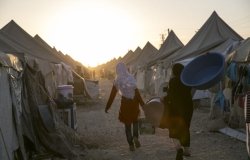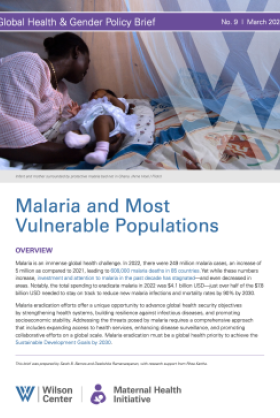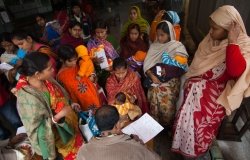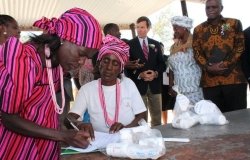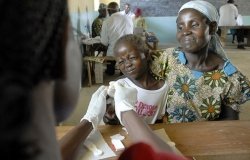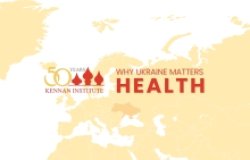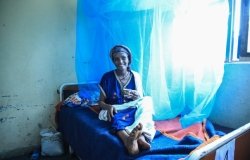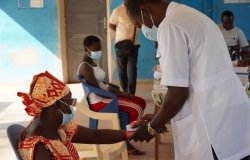Russia's Global Health Engagement
“The story of Russia’s engagement in global health—and in international development assistance more broadly—begins many decades ago,” remarked Judyth Twigg, Professor and Chair, Program in Political Science and International Studies, L. Douglas Wilder School of Government and Public Affairs, Virginia Commonwealth University; and Director, Eurasia Health Project and Senior Associate (Non-resident), Russia and Eurasia Program, CSIS. In her 5 November 2012 presentation, Twigg examined Russia’s transition from aid recipient to aid donor and what this shift in priorities means for Russia as a nation and as an international partner in global health initiatives.
Throughout much of the 20th century, the Soviet government contributed significant funding and resources in international assistance to developing nations. By the mid-1980s, the Soviet Union allocated around $25 billion a year to such projects, which were seen as an important means of exerting influence on the global political climate. With the collapse of the Soviet Union, however, this aid flow changed drastically. Russia became an aid recipient in the 1990s, receiving about $20 billion in aid between the years 1990 and 2004. Yet the status of aid recipient was not one that was wanted by Russia’s leaders.
Since 2005, Russia has drastically increased its international aid spending. “We are swinging the pendulum back in the other direction now,” noted Twigg. In order to create a strong global humanitarian presence to match its global financial presence, Russia’s “interest in being a donor and leader in overseas development assistance in general… and health assistance in particular, has been revived.” For example, Russia has reimbursed all of the funding it received from the Global Fund to Fight AIDS, Tuberculosis, and Malaria and continues to donate money to other international health organizations. This shift from aid recipient to aid donor was perhaps marked most notably by Russia’s request for USAID to withdraw from Russia at the end of September 2012. With the USAID pullout, Russia no longer receives any bilateral aid assistance, and its relationship with multilateral donors is undergoing significant changes.
Twigg suggested that two primary goals define Russia’s push to become a global health leader. First, Russia seeks to use global health leadership as an instrument for improving its international image. Second, becoming more active in global health efforts will allow Russia the opportunity to demonstrate its increased capacity and resources. Russia’s 2006 presidency of the G8, as Twigg noted, offered one of the first glimpses of Russia’s pursuit of the global health leader role. Russia used the G8 summit to outline specific health initiatives, placing infectious disease control and prevention firmly onto the agenda for the first time in G8 history. Since then, Russia has continued to seek active leadership in the international health community by contributing hundreds of millions of dollars of aid money to health organizations and by developing its own strategic plan for international health assistance.
Yet despite its increased efforts, Russia still faces significant barriers to becoming a global health powerhouse, many of which are self-inflicted. The Russian government lacks a coherent framework for international aid involvement: the country has no specific foreign aid budget, no course of study on aid management in national universities, and no agency responsible for carrying out international aid missions. This absence of infrastructure has led to bickering between various Russian agencies, most notably the Ministry of Finance and the Ministry of Foreign Affairs, over who controls the international aid portfolio and who is responsible for funding aid projects.
Twigg contended that these factors have shaped the way in which Russia has become involved in global health missions, as “virtually all of [Russia’s aid contributions] have gone through multilateral channels.” It is a model in which the majority of Russia’s global health and development contributions are limited to “the Ministry of Finance writing a check to some multilateral agency.” There is, however, an upside to this limited scope of involvement. Contributing funding without becoming involved in specific projects allows the Russian government to claim that it is having a meaningful impact on the global health landscape without having to spend time and resources developing its own institutions, capacity, policies, and personnel. And with Russia’s overall aid contributions reaching $500 million annually in the past few years, Russia is certainly moving toward a more prominent role on the global health stage.
Recently, Russia has gone beyond writing checks for certain global health initiatives. Twigg listed several recent health conferences that Russia has hosted, including the April 2011 meeting of the first-ever Global Ministerial Conference on Healthy Lifestyles and Noncommunicable Disease Control. Furthermore, Russia has taken steps to build its institutional capacity in order to become a “real” donor and carry out bilateral assistance projects of its own. Russia has begun working with agencies such as the World Bank and USAID in trilateral, hands-on partnerships that give Russian doctors, researchers, and other personnel the opportunity to travel into the field and work with their counterparts in active global health missions. But with the USAID pullout from Russia, these capacity building programs are threatened, as Russia’s involvement in such trilateral training partnerships has, at least for the moment, come to an end.
Twigg stated that Russia’s emergence as a global health leader is a positive development in the international development landscape. She suggested that the United States should strengthen and promote partnership with Russia in global health missions, despite such setbacks as the USAID withdrawal. The importance of health initiatives is widely recognized and easily agreed upon by both the United States and Russia, which can give rise to beneficial networking channels between the two governments. “The more we work together with our Russian colleagues,” Twigg emphasized, “the more we can teach them how to spend their resources more effectively and efficiently, and… given Russia’s determination to become a major player and leader on the global health stage, the more likely they are to be able to do that in a way that makes sense and is productive.” Indeed, as the United States and Russia continue to work together, “that goodwill,” concluded Twigg, “has the potential to spill over into the political and economic spheres where it is very much needed.”
By Kurt Hepler
William Pomeranz, Acting Director, Kennan Institute
About the Author

Kennan Institute
The Kennan Institute is the premier US center for advanced research on Russia and Eurasia and the oldest and largest regional program at the Woodrow Wilson International Center for Scholars. The Kennan Institute is committed to improving American understanding of Russia, Ukraine, Central Asia, the Caucasus, and the surrounding region though research and exchange. Read more
